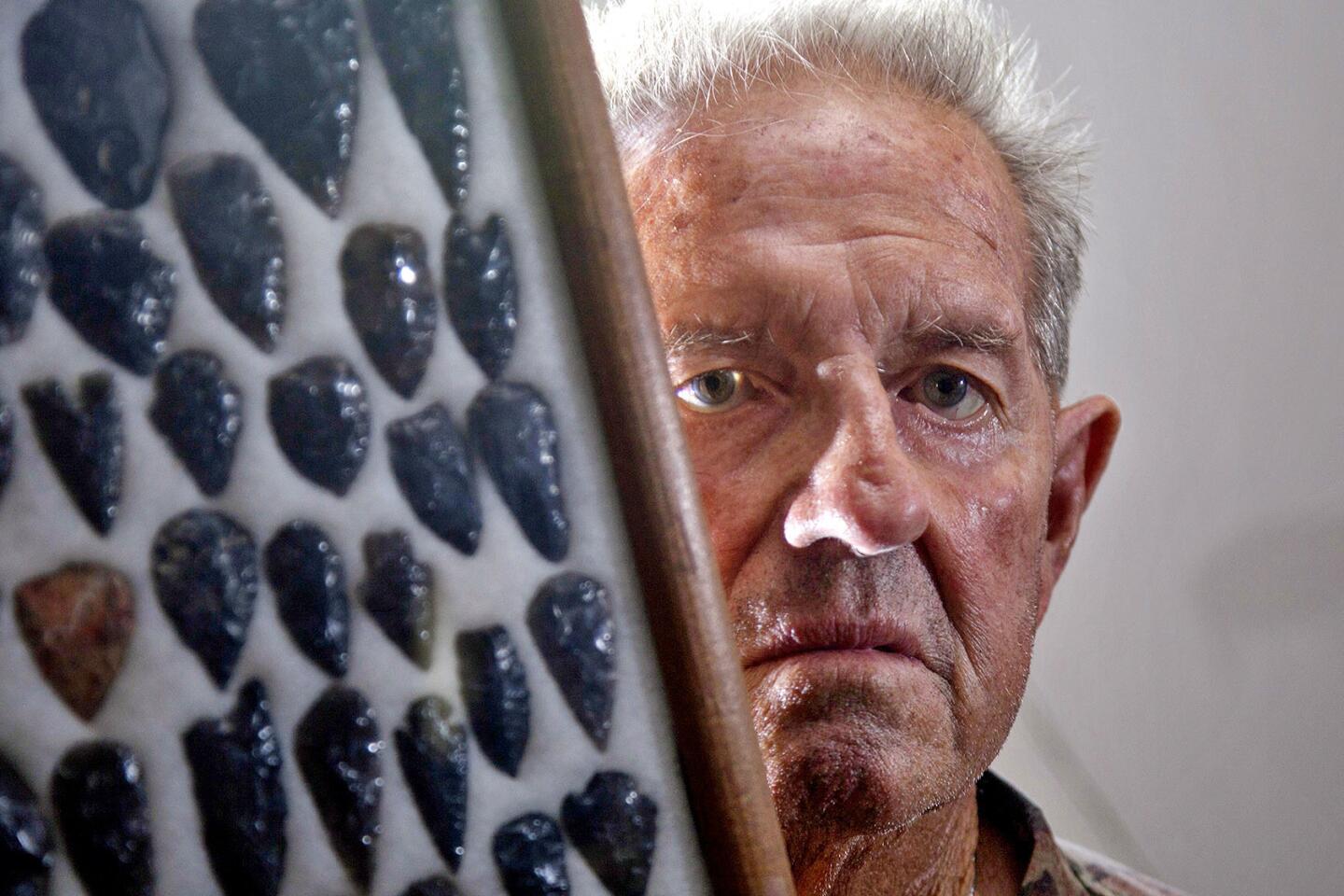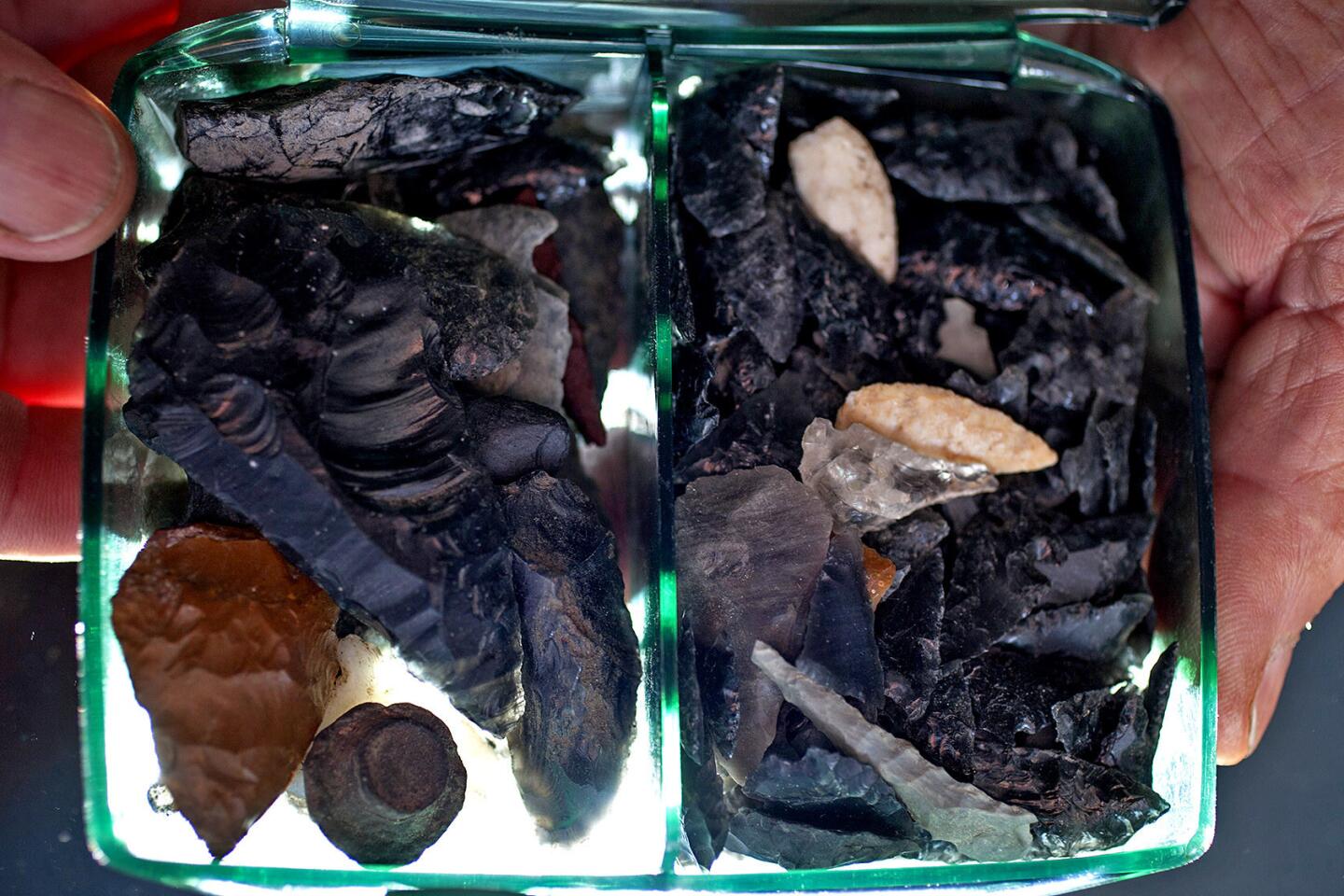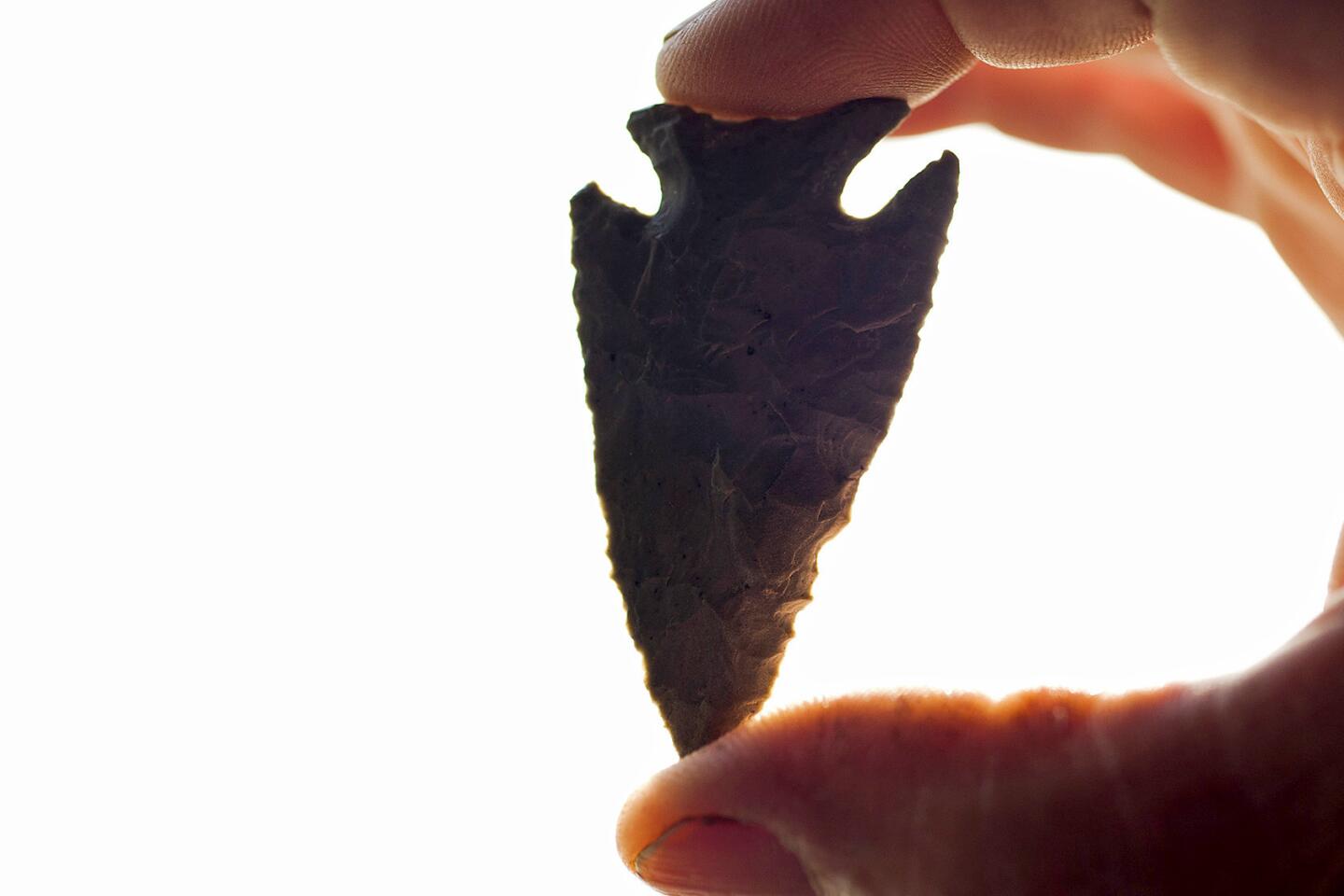Great Read: Owens Valley relic hunter not one to back down
Reporting From LONE PINE — Norman Starks, the anti-hero of Owens Valley, greeted a stranger at his door with something like a defiant haiku.
“Fifty-three Neanderthals,” he sputtered.
“Twelve hours.”
“I beat ‘em twice.”
Starks stood on his decrepit porch surrounded by relics of a Native American civilization that once flourished in this valley. His home and yard were strewn with hundreds of prehistoric cutting tools, granite bowls, beads, rock etchings, arrowheads and grinding stones.
They are his trophies, the product of a life’s obsession with gathering ancient artifacts from the surrounding lands — and they are the reason 53 federal agents raided his home last month on his 76th birthday.
Agents spent 12 hours rummaging through his century-old house, seizing artifacts they say he illegally dug up on public land.
“They made a real mess of things around here and scattered my prescription medicine bottles from hell to breakfast,” Starks grumbled.
“Thing of it is, I can explain everything, but the Neanderthals won’t listen to me.”
He hasn’t been listening to them, either.
The raid marked the third time in a decade that state and federal authorities have tried to end what they allege is his looting of the prehistoric items. The first two attempts failed.
Paiute-Shoshone tribal leaders and federal archaeologists say Starks has destroyed priceless cultural connections, along with scientific data that could help determine human behavior from the distant past.
Many of the items he has collected are sacred, they say, placed by loved ones at the graves of hunter-gatherers for use in the afterlife.
“What he’s doing is heartbreaking, disrespectful and illegal,” said Kathy Jefferson Bancroft, tribal historic preservation officer for the Lone Pine Paiute-Shoshone Reservation. “It must stop.”
Not going to happen, Starks says. Spend a couple of days with him and it’s easy to see why. His is a personality unacquainted with the concept of retreat.
He scoffs at the idea that the artifacts are sacred.
“The Indians that made this stuff didn’t think it was anything special,” he said. “They used it and tossed it aside. It was just used junk to them.”
::
Starks is ruggedly handsome if vaguely frail, with close-cropped gray hair, a sunburned face and a new kidney that has him off dialysis for the first time in years. He was once a star of cattle-roping competitions, and he worked as an aqueduct keeper for the Los Angeles Department of Water and Power before retiring.
His roots in the valley go back to his grandparents, pioneers who raised several children in what now serves as a storage shed on the property.
In the living room of the house he inherited from the family, coiled ropes, boxes of ammunition and cowboy hats are stacked among ancient tools used for processing food and chipping stone and wood into arrowheads, darts and spears.
The place once had a woman’s touch, but his wife left him for another man, he said, glancing out a dusty window pane.
Many of this town’s 2,000 people know Starks — and they know that the Eastern Sierra is dense with ancient Indian artifacts.
Like Starks, some believe the government has no business protecting the bits and pieces of history that occasionally surface in the sand or the foothills. They complain that the government is overreaching on Starks in particular.
“He’s a straight shooter,” a friend said.
A prison term would kill him, said another.
Yet even his buddies acknowledge that Starks has issues (which is the reason they don’t want to be quoted by name).
“Norman has a weird obsession and nasty habit of consciously thumbing his nose at critics,” said an Inyo County official.
As one old-timer said over a beer at the Chevron station, “If you’re a mouse, you don’t keep giving the finger to an eagle and not expect to get eaten.”
Starks said he can explain.
Leaning back on a dingy beige couch, he recalled that he started hunting for relics when he was 5. It was the early 1940s, when it was popular recreation in the sparsely populated region.
“On Sundays, families went to church and then went arrowhead hunting,” he said.
As the decades passed and Native Americans began objecting to the collection of relics, many locals cut back or stopped altogether.
Not Starks.
“I’d rather do that than sit in a bar or watch video games,” he said. “It’s a great way to get some exercise and give my dogs a run.”
::
The original federal case against Starks, under the Archaeological Resources Protection Act, fizzled in 2004 after the statute of limitations ran out.
The state then made a run on charges he was looting artifacts on DWP land, but the case ended with a hung jury in 2011. Too many of his peers had their own cherished collections of relics.
Before that case ended, however, Starks agreed to a court order barring him from ever setting foot on a 700-acre patch of Keeler Dunes, a slice of Bureau of Land Management land rich with relics.
The agreement didn’t stop him from collecting. Instead, he insists that he limited himself to artifacts found legally on private property near the restricted area. Now, he said, authorities are trying to frame him.
Some of the evidence seized during the June 26 raid was “planted in my house,” he said. Other relics “were stolen by the investigators and archaeologists while they were going through all my stuff.”
Their motive? He said they are in a conspiracy with tribal leaders and the DWP to stop a lawsuit he filed against the water agency. The lawsuit, scheduled for trial Sept. 15, accuses the DWP of illegally seizing control of century-old water rights on his property.
“That water is worth millions,” Starks said.
DWP workers with binoculars and cellphones routinely alert other conspirators to his whereabouts, he said. If the telephone rings and the caller fails to leave a message, he assumes it’s a tribal official.
“If I answer the phone, they call off the dogs because they know I’m home.”
To toy with them, he said, he often doesn’t answer.
Starks has special scorn for Bancroft, the Paiute-Shoshone preservation officer. He thinks she has a vendetta against him and won’t stop “as long as she is alive.”
And then there’s Gregory J. Haverstock, a federal archaeologist devoted to stopping Starks.
Haverstock provided critical evidence in the state case that failed three years ago. He reported seeing Starks use a golf club in 2009 to dig near a prehistoric burial site in Keeler Dunes.
Starks claimed he was searching for old coins along a railroad line when Haverstock saw him. He said the railroad easement is private property.
An archaeological report said 44 holes were found clustered in the immediate vicinity of the burial site, about 100 feet uphill from the rail line.
“The suspect’s footprints were noted at each location as well as dog prints,” the report said.
Federal authorities decline to comment on last month’s raid. If the case goes to trial, it will be heard by a Fresno jury far removed from Starks’ peers in Lone Pine.
Even so, he’s brimming with confidence.
“They say they have a picture of me in the place I wasn’t supposed to be,” Starks said of photos the government reportedly has showing him at the dunes. “But they’re wrong.”
What was he doing near the dunes?
“I was looking for old coins along a railroad easement, which is private property.”
The golf clubs?
“I use them for walking sticks” and fending off rattlesnakes.
Where did he get the pile of massive stone relics on his front porch?
“They were my grandfather’s.” He said 90% of his collection predates federal laws against taking items from public land.
Holding up a picture frame display of arrowheads, his eyes brightened and his voice ticked up a notch.
“It’s just a natural high to find things this old and wonder who did it,” he said.
Besides, he added, “arrowheads are as common as goats’ asses around here.”
Twitter: @LouisSahagun
More to Read
Sign up for Essential California
The most important California stories and recommendations in your inbox every morning.
You may occasionally receive promotional content from the Los Angeles Times.














